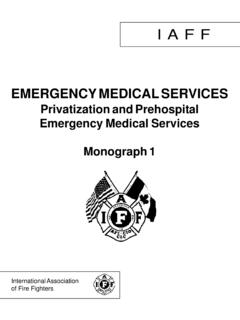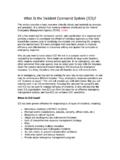Transcription of Module 8: Decontamination - IAFF Main
1 Module 8: Decontamination 8-1 Student Text IAFF Training for Hazardous Materials: Technician Module 8:Decontamination8-2 Module 8: DecontaminationIAFF Training for Hazardous Materials: Technician Student TextModule 8: Decontamination 8-3 Student Text IAFF Training for Hazardous Materials: Technician Module 8: DecontaminationModule DescriptionThis Module covers the types, levels, and process of Decontamination . Step-by-step decontami-nation procedures are explained, as well as the set-up of the area and equipment. Special decon-tamination situations such as decon for radiation and etiologic agents are discussed at the end ofthe Students should have completed a hazardous materials operations level training program. Students should have completed Module 7: Personal Protective Equipment of this Module 8: DecontaminationIAFF Training for Hazardous Materials: Technician Student TextObjectivesUpon completion of this Module , participants will be able to: Define the term Decontamination .
2 Explain the difference between emergency Decontamination and technical Decontamination . Describe circumstances requiring emergency Decontamination andtechnical Decontamination . Describe the following Decontamination techniques: Dilution Washing Absorption Adsorption Isolation Chemical degradation Disposal Evaporation Neutralization Solidification Vacuuming Identify considerations associated with the placement and setup ofdecontamination areas. Explain the importance of the following in setup and procedures usedin Decontamination : Physical and chemical properties of contaminant Activities performed by entry and decon teams Level of probable contamination of personnel and equipment Probable areas of contamination on individual personnel Describe the importance of Decontamination of decon personnel andequipment. Identify the factors to be considered in selecting appropriate PPE fordecontamination personnel.
3 Identify three sources of technical information for selecting appropri-ate Decontamination procedures. Given the possible contaminants, activities of an entry team, andappropriate resources, choose: An appropriate site for Decontamination Level of protection for the decon team Procedures to be used by decon personnel according to thejurisdiction s Decontamination plan Execute the decon plan by deploying appropriate equipment andperforming 7-2471 7-2471 7-3472 4-1 (5)472 7472 7-1 OSHAS tandards29 CFR (q) (6) (iii) (G)29 CFR (q) (6) (iii) (G)29 CFR (q) (6) (iii) (G)29 CFR (q) (6) (iii) (G)29 CFR (q) (6) (iii) (G)29 CFR (q) (6) (iii) (G)29 CFR (q) (6) (iii) (G)29 CFR (q) (6) (iii) (G)29 CFR (q) (6) (iii) (G)29 CFR (q) (6) (iii) (G) Module 8: Decontamination 8-5 Student Text IAFF Training for Hazardous Materials: Technician 8-6 Module 8: DecontaminationIAFF Training for Hazardous Materials.
4 Technician Student TextModule 8: Decontamination 8-7 Student Text IAFF Training for Hazardous Materials: Technician Module 8 Prerequisite Quiz1) When must a Decontamination area be set up?a) As soon as the hazardous materials team arrivesb) When personnel enter the Hot Zonec) Before personnel enter the Hot Zoned) When the backup team is suited2) In emergency Decontamination , which of the following is a primary concern?a) Remove solid ) Remove all contaminants ) Avoid secondary ) Prevent severe ) If contaminants are corrosive, skin and mucous membranes must be flushed with:a) Large amounts of waterb) No waterc) Just enough water to remove the contaminantd) Large amounts of a neutralizing solution4) Non-soluble contaminants should be removed from the skin with:a) Waterb) Liquid soap and waterc) An oil-based Decontamination solutiond) Dry blotting5) Although other factors are involved, protective clothing is more likely to be permeated if.
5 A) The contaminant is a liquid rather than a gas or ) The ambient temperature is relatively ) The chemical saturates a small area rather than a large ) The chemical is highly ) Deactivation is the use of cleaning agents, neutralizers, or disinfectants for decontamina-tion and is generally used for:a) Loose solid contaminantsb) Contaminants mixed with dust or debrisc) Volatile liquidsd) Organic compounds7) In the Decontamination process for liquid splash-protective garments, the SCBA facepiece isremoved:a) As soon as possibleb) After outer garments (boots and gloves) are removedc) After the splash suit is removedd) After a personal shower8-8 Module 8: DecontaminationIAFF Training for Hazardous Materials: Technician Student Text8) How should you decontaminate a contaminated entry team member who experiences heatstress in the Hot Zone?
6 A) Do not decontaminate; remove the protective clothing immediatelyb) Perform an emergency Decontamination , then remove the clothingc) Perform a thorough Decontamination , then remove the clothingd) Cool the responder, then thoroughly decontaminate and remove the clothing9) Exposure to which type of chemical automatically prohibits the reuse of PPE?a) Carcinogensc) Hydrocarbonsd) Combustible liquidse) Organic peroxides10) PPE contamination levels can only be determined by:a) Thorough visual examinationb) Wipe samplingc) Analysis of spent decon solutionsd) Destructive testingModule 8: Decontamination 8-9 Student Text IAFF Training for Hazardous Materials: Technician IntroductionQuestions1. What are the two main types of contamination?2. Which type of contaminant is easier to remove, water-soluble or water-insoluble?
7 Liquids or solids? Viscousor non-viscous liquids?3. How do you decontaminate CPC contaminated with awater-reactive chemical?At the Hazardous Materials Technician level, responders aretrained to enter areas where contamination exists and carryout activities that may result in contamination of theirprotective clothing. They may also be called upon toperform rescue of unprotected is only logical given the premise that you are likely toget dirty that equipment and procedures be employedthat will ensure you get clean .Your main mission is to leave the scene in better conditionthan when you arrived to positively affect the outcome ofthe incident. Decontamination procedures can prevent thecontaminant from spreading away from the initial area( secondary contamination ) and therefore reduce thechance of exposure to people in other RegulationsOSHA defines Decontamination as the removal of hazard-ous substances from employees and their equipment to theextent necessary to preclude the occurrence of foreseeableadverse health effects.
8 Basically it is the process used tomake personnel, equipment, and the area safe by eliminat-ing or reducing exposure to harmful substances. In actual-ity, Decontamination is a fancy term for what our mothersalways told us wash up well .8-10 Module 8: DecontaminationIAFF Training for Hazardous Materials: Technician Student TextOSHA (q)(3)(ix) states After emergency opera-tions have terminated, the individual in charge of the ICSshall implement appropriate Decontamination procedures. OSHA (q)(6)(iii)(H) states Technicians shall understand and implement Decontamination procedures. These laws offer little guidance, other than specifying thatdecontamination must be 8: Decontamination 8-11 Student Text IAFF Training for Hazardous Materials: Technician Contamination andDecontaminationTypes of ContaminationThere are two main types of contamination: surfacecontamination and permeation vs.
9 Permeation ContaminationSurface contamination occurs when product remains on thesurface of a protective garment. Dusts and other solids areusually surface contaminants. Liquids that do not permeategarment material remain as surface contaminants. Surfacecontamination is the easier type of contamination to detectand contamination, on the other hand, is difficult todetect. Permeation contamination occurs when a contami-nant soaks into a protective garment. Once the product hasbegun traveling through the material, it is very difficult toremove. If a suit is not being worn, sometimes it is best toallow a chemical to finish its journey before trying to dealwith it. You can judge whether this type of contaminationhas occurred based on the properties of the chemical, theproperties of the protective material, and the time, area andconcentration of and Secondary ContaminationThere are also two methods of becoming contaminated:direct and secondary contamination, also referred to contamination occurs when an object or personcomes into direct contact with the contaminant.
10 In manyinstances it cannot be avoided (such as plugging and patch-8-12 Module 8: DecontaminationIAFF Training for Hazardous Materials: Technician Student Texting a large leak). However, all efforts should be made toavoid contact through the use of procedures, work practicesand remote contamination occurs when a clean object orperson comes into contact with a contaminated object orperson. This is usually the result of poor management ofthe scene, inadequate procedures, or procedures that werenot of DecontaminationThere are two main types of Decontamination : emergencydecontamination and technical Decontamination . Thebest way to protect yourself, however, is to avoid contami-nation in the first clean is the best type of Decontamination . Workpractices that stress non-contact with hazardous chemicalsshould be developed and stressed.











